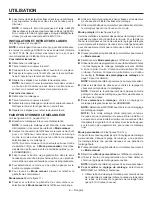
3 - English
GENERAL POWER TOOL SAFETY WARNINGS
MIXER SAFETY INSTRUCTIONS
Hold the tool with both hands at the intended handles.
Loss of control can cause personal injury.
Ensure sufficient ventilation when mixing flammable
materials to avoid a hazardous atmosphere.
Developing
vapour may be inhaled or be ignited by the sparks the
power tool produces.
Do not mix food.
Power tools and their accessories are
not designed for processing food.
Keep the cord away from the working area.
The cord
may be entangled by the mixing paddle.
Ensure that the mixing container is placed in a firm
and secure position.
A container that is not properly
secured may move unexpectedly.
Ensure that no liquid splashes against the housing of
the power tool.
Liquid that has penetrated the power tool
can cause damage and lead to electric shock.
Follow the instructions and warnings for the material
to be mixed.
Material to be mixed may be harmful.
If the power tool falls into the material to be mixed,
unplug the tool immediately and have the power tool
checked by a qualified repair person.
Reaching into the
container with the tool still plugged in can lead to electric
shock.
Do not reach into the mixing container with your hands
or insert any other objects into it while mixing.
Contact
with the paddle may lead to serious personal injury.
Start up and run down the tool in the mixing container
only.
The paddle may bend or spin in an uncontrolled
manner.
Know your power tool. Read operator’s manual
carefully. Learn its applications and limitations, as well
as the specific potential hazards related to this tool.
Following this rule will reduce the risk of electric shock,
fire, or serious injury.
Always wear eye protection with side shields marked
to comply with ANSI Z87.1.
Following this rule will
reduce the risk of serious personal injury.
Protect your lungs. Wear a face or dust mask if the
operation is dusty.
Following this rule will reduce the risk
of serious personal injury.
Protect your hearing. Wear hearing protectors during
extended periods of operation.
Following this rule will
reduce the risk of serious personal injury.
Inspect tool cords periodically and, if damaged, have
repaired at your nearest authorized service center.
Constantly stay aware of cord location.
Following this
rule will reduce the risk of electric shock or fire.
Check damaged parts. Before further use of the
tool, a guard or other part that is damaged should
be carefully checked to determine that it will operate
properly and perform its intended function. Check for
alignment of moving parts, binding of moving parts,
breakage of parts, mounting, and any other conditions
that may affect its operation. A guard or other part that
is damaged should be properly repaired or replaced
by an authorized service center.
Following this rule will
reduce the risk of shock, fire, or serious injury.
Make sure your extension cord is in good condition.
When using an extension cord, be sure to use one
heavy enough to carry the current your product will
draw. A wire gauge size (A.W.G.) of at least 14 is
recommended for an extension cord 50 feet or less in
length. A cord exceeding 100 feet is not recommended.
If in doubt, use the next heavier gauge. The smaller
the gauge number, the heavier the cord.
An undersized
cord will cause a drop in line voltage resulting in loss of
power and overheating.
If the power supply cord is damaged,
it must be replaced
only by the manufacturer or by an authorized service
center to avoid risk.
Never leave mud mixer running unattended.
Unplug
mixer when leaving work area or when mixer is out of
your line of sight.
Save these instructions.
Refer to them frequently and
use them to instruct others who may use this tool. If you
loan someone this tool, loan them these instructions also.
Keep cutting tools sharp and clean.
Properly maintained
cutting tools with sharp cutting edges are less likely to
bind and are easier to control.
Use the power tool, accessories and tool bits etc.
in accordance with these instructions, taking into
account the working conditions and the work to be
performed.
Use of the power tool for operations different
from those intended could result in a hazardous situation.
Keep handles and grasping surfaces dry, clean and
free from oil and grease.
Slippery handles and grasping
surfaces do not allow for safe handling and control of the
tool in unexpected situations.
SERVICE
Have your power tool serviced by a qualified repair
person using only identical replacement parts.
This
will ensure that the safety of the power tool is maintained.




































